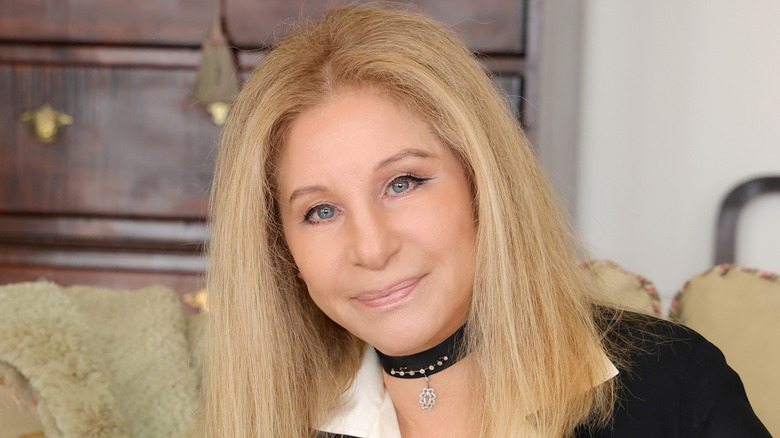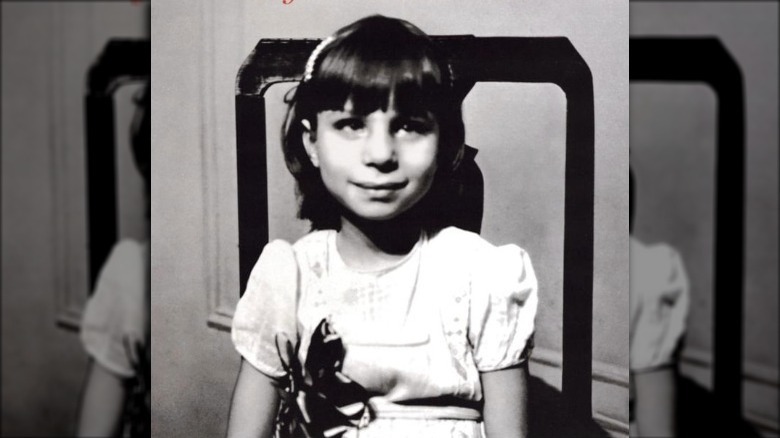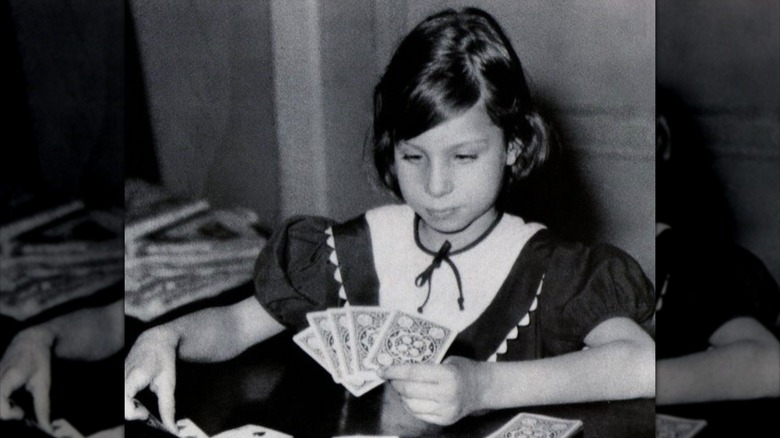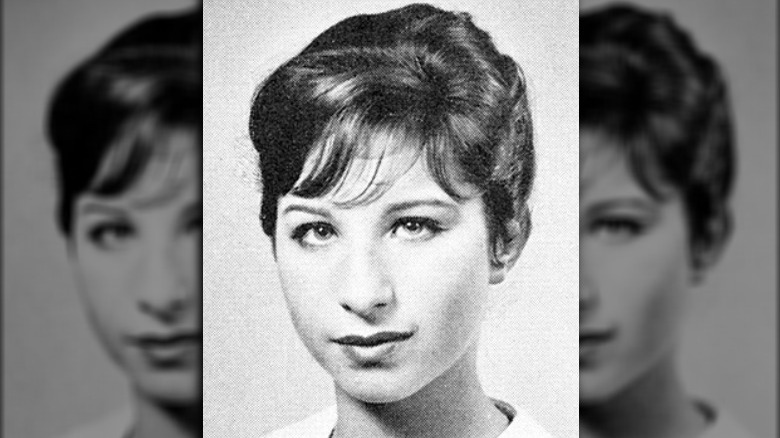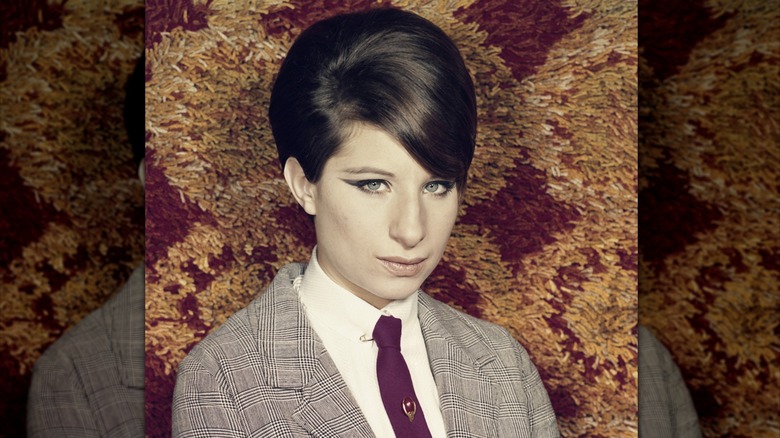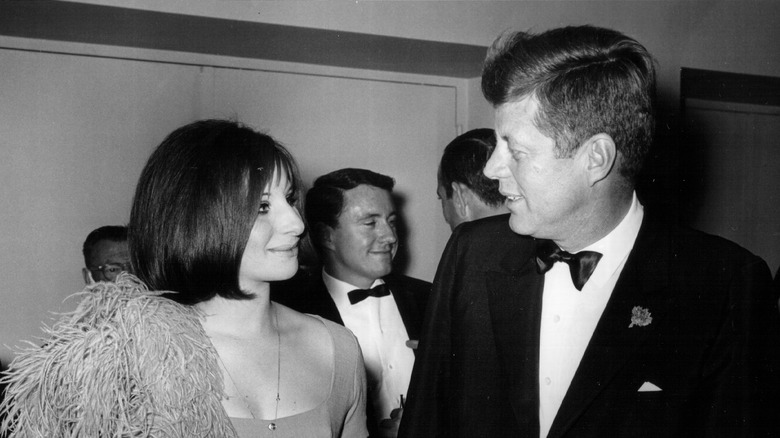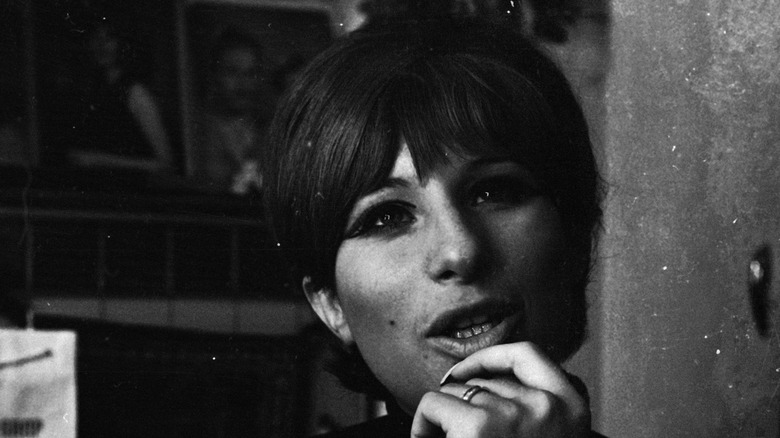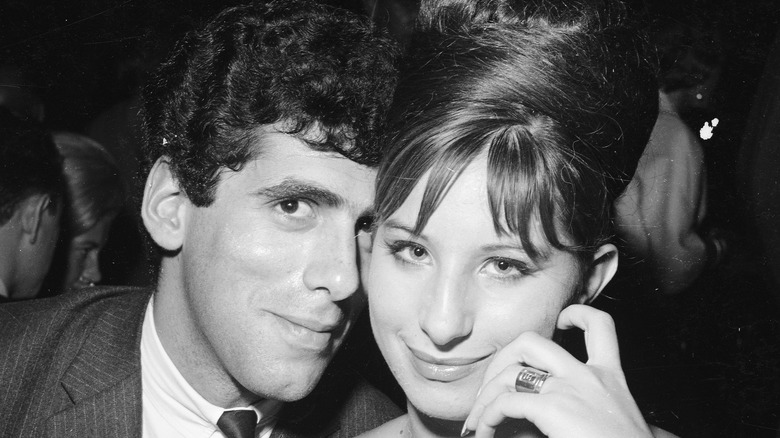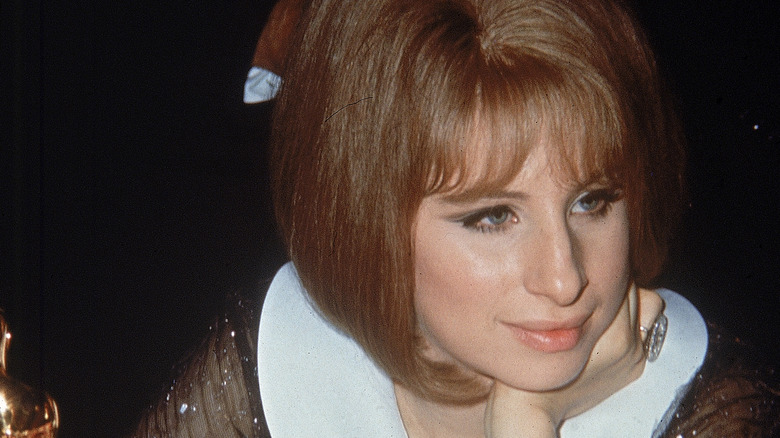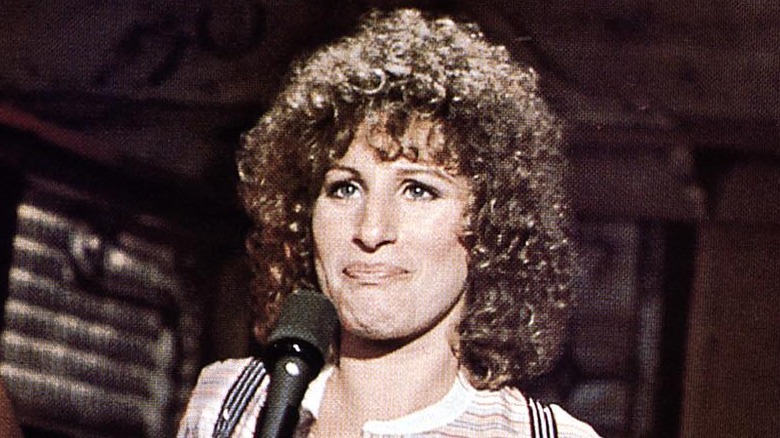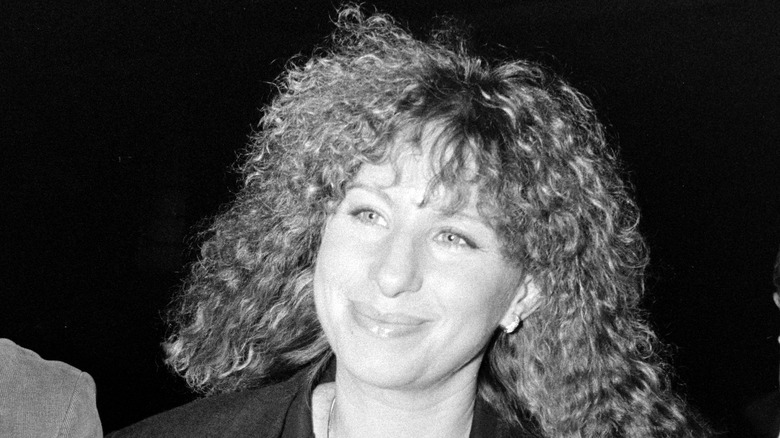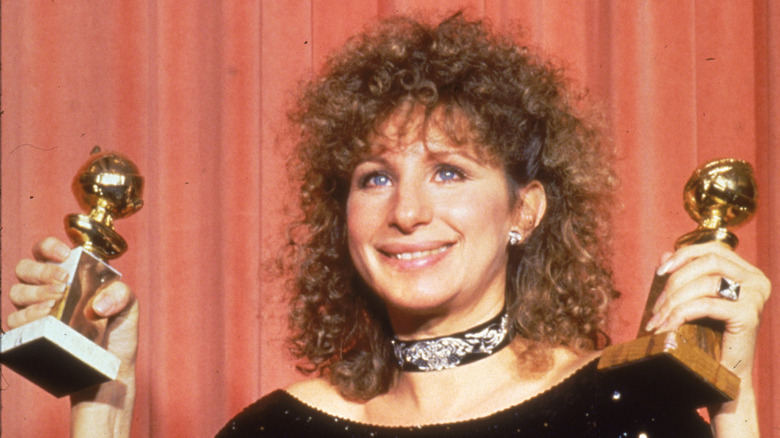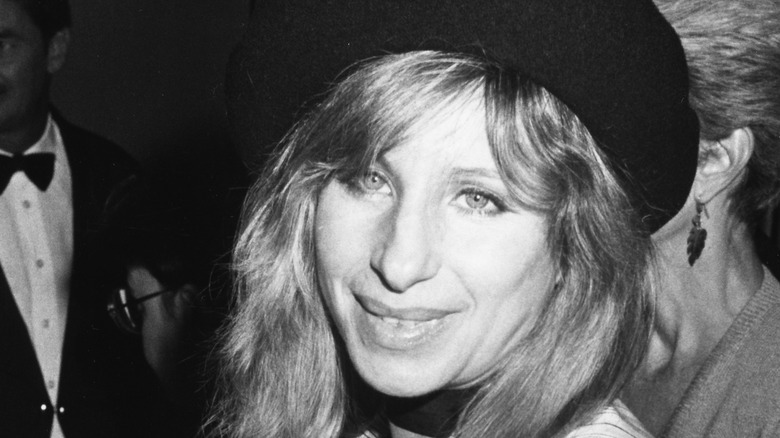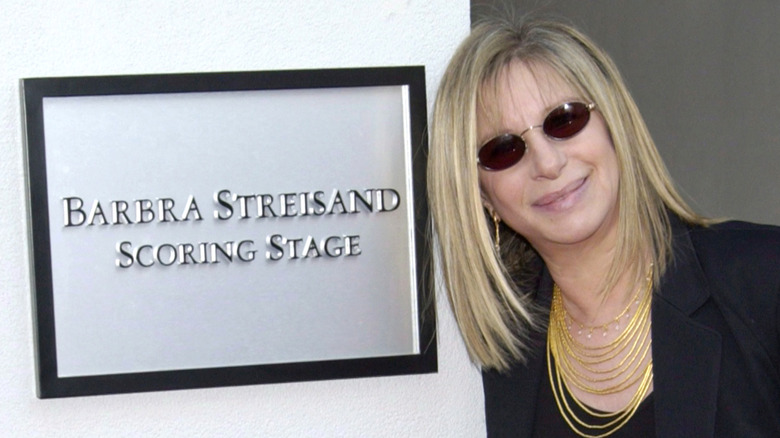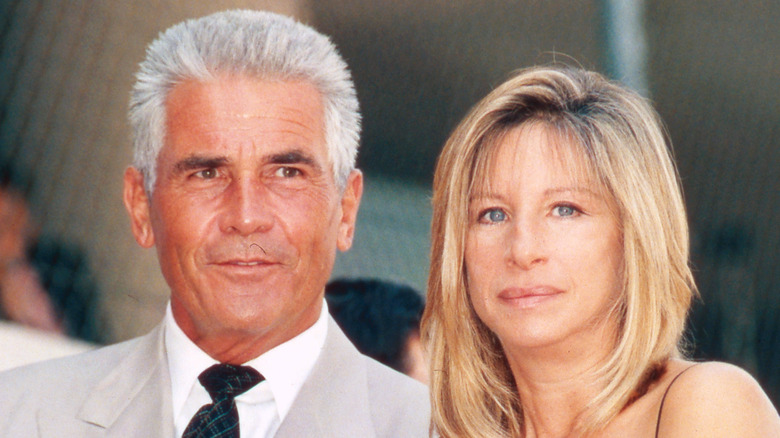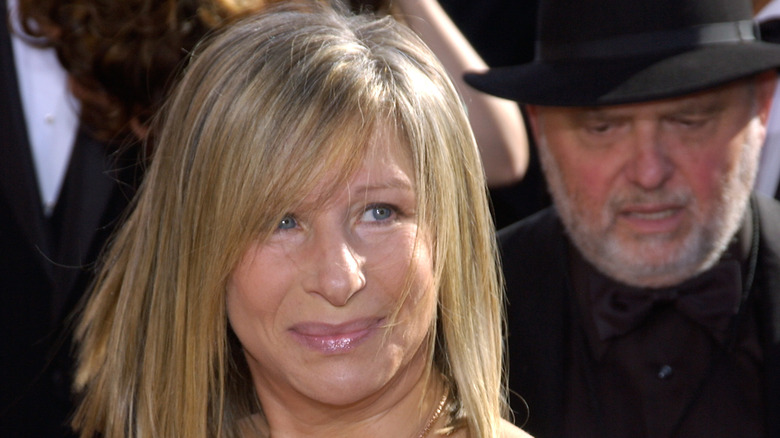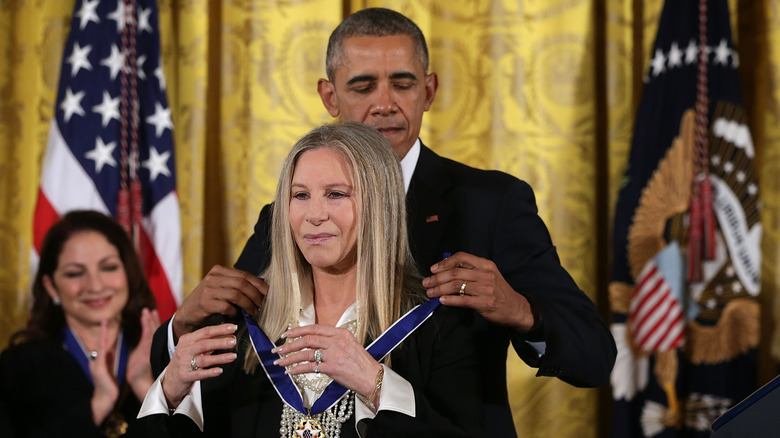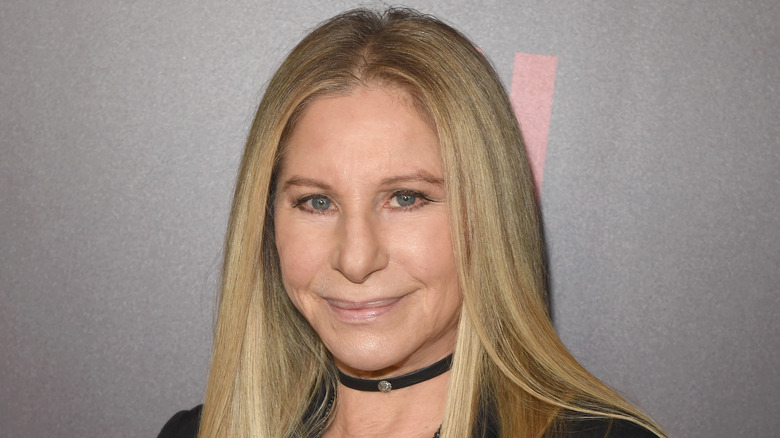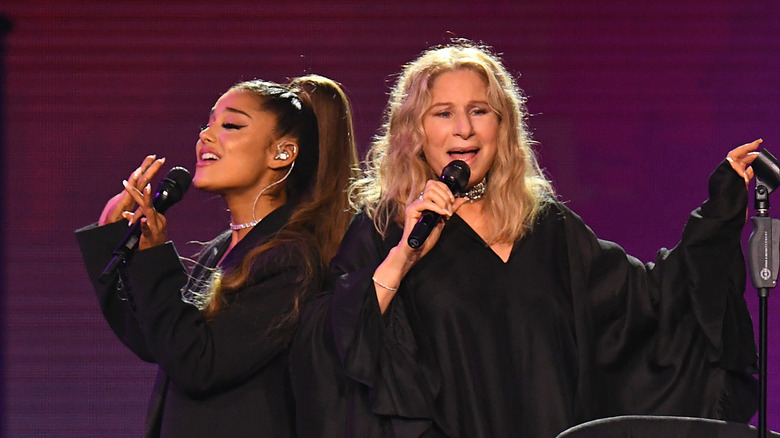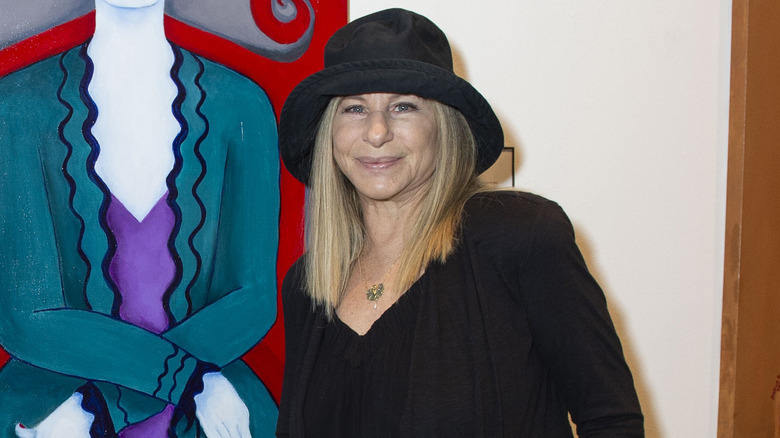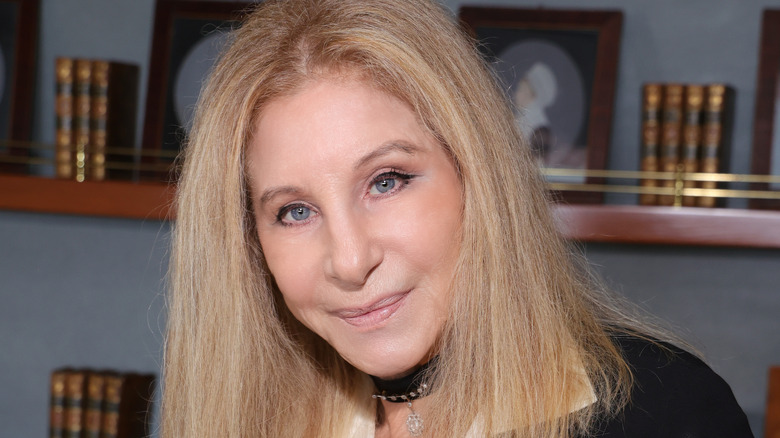The Transformation Of Barbra Streisand
Barbra Streisand became an American icon through her many talents. Known primarily as a singer, this legend "became the only singer to land a No. 1 album in six successive decades," according to The New York Times. But showing her true versatility, Streisand dominated in all forms of entertainment. She started out as a Broadway star for "Funny Girl," and quickly moved into TV and film. Her role in the movie version of "Funny Girl" earned her an Oscar. In fact, she even landed the four major entertainment awards — an Emmy, Grammy, Oscar, and Tony — making her part of a rare group of "EGOT" winners.
As a celebrity, Streisand made the news for her relationship with photographers. Writer Mike Masnick coined the term the "Streisand Effect" soon after the singer sued an aerial photographer for posting pictures of her California home online, via Techdirt. Prior to the lawsuit, "the image had been viewed six times (including twice by Streisand's lawyers), but following the news of the lawsuit, hundreds of thousands of people went to see the photo." The phrase became used for someone asking for privacy, only to receive more attention because of it. And later in her career, Streisand stirred intrigue thanks to her involvement in a modern-day science marvel.
Streisand's life is an incredible story, from a difficult childhood to awards galore. This is the transformation of one of America's most beloved songstresses.
The early days of Barbra Streisand
Barbra Streisand was born in New York City in the middle of World War II. And sadly, her father, Emanuel, died when she was barely a year old. She grew up in Williamsburg, Brooklyn with her older brother Sheldon and mother Diana. And Streisand became known around town as the "girl with no father and a good voice," according to The New York Times. That's because she was already singing as a five-year-old. Some of her talent comes from her mother, who "had a natural operatic voice but never sang professionally." The album art on one of Streisand's early works, "My Name is Barbra," shows the young girl.
Her mother remarried, which gave Streisand her half-sister Roslyn Kind. But something seemed off for the young Streisand. "I didn't really like my life as a child," she said, adding, "I thought, 'This can't be it.'" She was right — and went on to become an icon. But looking back at her childhood, Streisand felt that growing up without her biological father affected her habits. As a collector of fine art, she said of her hobby, "Sometimes I think it's all connected to the loss of a parent." She revealed, "you'd do anything to get that mother or father back. But you can't." Even in interviews, Streisand still is sure to mention her father. She explained how as an English teacher, he would visit inmates at an Elmira prison to teach classes.
Streisand's family struggled during her childhood
The hole that her father left in the family when he died from a head injury at the age of 35 — when she was just more than 1-year-old — was also an ever-present part of Barbra Streisand's childhood. Even after all her success later in life, Streisand still wondered if her early years would have been different if her father was still around. The singer revealed she keeps her dad's old copy of the children's book, "Tales From Shakespeare," in her bedroom for sentimental reasons. "Who knows? Maybe he had bought it to read to me," Streisand explained in her 2023 memoir, "My Name Is Barbra" (via The New York Times).
While living in the Flatbush neighborhood of Brooklyn as a kid, her family didn't have a ton of money. For example, Streisand recalled that she didn't have a real doll to play with and instead used a bottle filled with hot water. "I swear it felt more like a real baby than some cold doll," Streisand recalled in her memoir. Still, she confessed that it would have been nice to have a proper toy to play with. "Even now, when I see children with their dolls and little stoves and things, I want to play with them too," Streisand wrote. The future star also later found out that all along since she was a child, she had been living with tinnitus, a condition that causes ringing sounds in the ears.
Her life as a student
While going to school in Brooklyn, Barbra Streisand excelled at her schoolwork. And she spent some downtime with another future celebrity. She went to Erasmus High School at the same time as singer Neil Diamond. He told The Daily Mirror about his former classmate, "We were two poor kids. We hung out in the front of Erasmus High and smoked cigarettes."
In addition to smoking with Diamond, Streisand was gifted enough to even graduate high school early. For a career, the young woman decided to move to Manhattan and try to make it as a performer. Streisand's mom wasn't fully behind her decision and "warned her daughter not to pursue a career in show business," The New York Times reported. Streisand claimed her mother told her, "I didn't look like the movie stars I read about in magazines."
While in Manhattan, Streisand started out working side jobs "as a clerk and phone operator for a printing company" — a way she could audition for acting roles. But she was fired from her job and "was being repeatedly rejected for acting gigs." At this turning point, Streisand started to show off her vocal talents. She began to sing in "Greenwich Village nightclubs as a gawky teenager in thrift-shop clothes in the early 1960s," according to The New York Times.
How Streisand found her talent
Barbra Streisand's high school didn't have any acting classes, so instead she applied to a local radio club. After a successful audition, Streisand admitted she was more interested in being accepted than the group itself and immediately dropped out of the club. Fortunately, her school had a choral club for the young singer to practice her vocals. As Streisand recalls, she was never singled out for a spectacular voice and claimed the teacher was never impressed with her vocals.
Yet, Streisand's mom believed in her daughter and took her to audition for MGM when she was 9 years old and a few years later to an audition for the TV series "Startime Kids." Though none of these roles panned out, Streisand gained confidence, and as a teen, she and her mother even started recording music together in a studio. Outside of school, she also began to take acting classes. "I was like a sponge at this time, drinking everything in," Streisand recalled in her memoir, "My Name Is Barbra." She added, "acting class was where I felt creative."
One particularly memorable moment for Streisand was when she personified a chocolate chip cookie. A fellow actor later invited her to his audition for The Actors Studio and while he wasn't accepted, the judges were so impressed by Streisand's part that they asked her to come back and audition on her own. She wasn't accepted to the prestigious studio, but used this as a motivating challenge to perfect her craft.
Streisand's amazing start in music
In 1963, Barbra Streisand commercially kicked off her music career with the release of her debut album, "The Barbra Streisand Album." The album cover features a photograph of Streisand singing on stage at the Bon Soir club in New York. The singer was only in her early 20s. And behind the scenes, Streisand had a major part in the release of her album. Despite being her debut, the singer won contractual control over the album, including the photo for the cover art, according to The New York Times.
Looking back at this era of making music, Streisand recalled the creative process was much more manual. "When I first started out in the early '60s, by necessity and circumstance, we worked fast. We didn't have the time, budget or technology to record an infinite number of tracks," she noted in a statement for her "Release Me 2" album. "As a result of these so-called 'limitations,' we had fewer decisions to make about the best takes or mixes," she added. The result worked — the album was a critical success and earned Streisand a nomination at the 6th Grammy Awards. Her debut went on to win "Album of the Year."
Streisand's super year continued when she landed in Washington D.C. for one of the most prestigious events in politics. She sang for then-president John F. Kennedy at the White House Correspondents' Dinner, via The New York Times.
Her big moment in the Big Apple
The dream of a young hopeful moving to New York City to become a star came true for Barbra Streisand. Though she was trying to find acting work, she got her first big break, not through drama, but singing. A Manhattan gay bar called the Lion held a talent contest, with the winner allegedly earning "$50 and a free dinner of London broil," a cut of steak, The New York Times reported. Using the stage name "Smyrna" — named after the Greek city — Streisand sang two songs and won the competition. She continued to perform weekly at the bar, and then in another club in Manhattan called Bon Soir. A director, Arthur Laurents, spotted the talented young singer and hired her to appear in the musical "I Can Get It for You Wholesale." With her incredible performances now for the masses, Streisand "became a Broadway star." But her breakout role was in the 1964 musical "Funny Girl" — and she almost never even had the chance to star in the show. Reportedly, "the producers only settled on her after Anne Bancroft and Carol Burnett turned down the role."
At the 2001 BAFTA awards, Streisand earned the Life Achievement Award. Phyllis Diller, a famous singer, appeared on stage to introduce Streisand. She explained how Streisand opened for her at the Bon Soir club a long time ago. "So, I thought that I'd open for her tonight," Diller said, as recapped by Variety.
Inside Streisand's original TV appearance
In 1963, Barbra Streisand married actor Elliott Gould. The red-hot youngsters quickly became the "It" couple of the early sixties. Soon after, Streisand found something else to love — a huge TV deal. In 1964, she "signed a $5 million, 10-year contract with CBS," according to Jewish Women's Archive. The singer and actor began to craft what would become her first TV special called "My Name is Barbra." And Streisand allegedly had full control over the creative process. "You can imagine how nervous that made the network," Streisand said a few of her choices scared CBS "when they learned that there would be no major guest stars, not even any minor ones — just me and a bunch of great songs and some wonderful musicians."
The special featured Streisand singing alone with only a backing chorus and dancers for certain parts. In 2018, Streisand posted a video clip from the special on her X, the platform formerly known as Twitter, account. The young woman is dressed in a skirt with pigtails, and singing her song "I'm Five" in a playground stage set. The show was a huge success for Streisand. And the special "won five Emmys and a Peabody Award." As a result, CBS gave Streisand two additional specials to continue to show off her wide variety of talents.
Streisand went from stage theater to movie theaters
As Barbra Streisand's recognition increased as a talented singer and stage actor, she set her sights on Hollywood. At the time, even a rising star like Streisand had a difficult time breaking into the film industry. In the 1960s, Judy Garland spoke with Streisand on the downfalls of being a woman in Hollywood. "Don't let them do to you what they did to me," Garland supposedly told the young singer, The New York Times reported.
But similar to her first record deal, Streisand was able to play a major role in the creative process, even when the odds seemed against her. For Streisand's debut film, she starred in the adaptation of the Broadway musical "Funny Girl" in 1968. During the filming process, Streisand "watched the dailies with its Oscar-winning director, William Wyler, offering her opinions along the way and learning the craft from one of its masters."
At a time when "actresses did not direct," as Streisand said, she found a way to do just that. And when it came time for her salaries, she also didn't take no for an answer. In Streisand's film "The Way We Were," the male lead Robert Redford reportedly earned $400,000 less than her. As reconciliation for the sequel, Streisand "requested a $400,000 director's fee to make up the pay difference." When the producer refused, Streisand simply backed out of the project.
Streisand's starred in the remake of A Star is Born
The 1954 film "A Star is Born" starred Judy Garland and James Mason as lovers and singers. Over twenty years later, Barbra Streisand reprised the role as the female lead alongside Kris Kristofferson. More than just bringing in audiences, Streisand helped start a new mindset in the film industry. Until that time, male actors often "negotiated for a percentage of a film's gross revenue, rather than the often nonexistent net profit," according to The New York Times. Streisand became one of the few female actors who negotiated the same for herself in the 1976 remake. One of Streisand's former agents, Michael Ovitz, remembered how Streisand was able to land the contract. "It wasn't easy," he said, because "the business didn't value women as much as men. Barbra could be tough as nails." And according to the Hollywood agent, "She stood up for what she believed in, with enormous integrity."
For the 2018 remake with Bradley Cooper and Lady Gaga, Streisand gave advice to Lady Gaga on how to succeed in the role. Streisand told E! News, "I told her to do it live, and she wanted to do it live, so that's good because that's the best way to do it," referencing the song components of the movie. And the actor shared her comments on the updated version. Even though she noted "their songs are different" from her film, Streisand claimed, "it's a good movie, it's gonna be a hit."
She continued to grow her resume
As an already established singer and actor, Barbra Streisand showed she had even more ways to express her talent. In 1983, Streisand made her directorial debut with the film "Yentl." The film was based on a short story by Isaac Bashevis Singer called "Yentl the Yeshiva Boy." Streisand bought the rights to the story with the intention to make a "nonmusical, black-and-white art film," according to The New York Times. But according to Streisand, the film industry wanted her star power on full display to help push audiences to see the film. She remembered, "the only way I could get 'Yentl' made was to sing in it." Not only did she direct and star in the film, but the multitalented Streisand also co-wrote the screenplay and produced the musical.
The film was a hit and made over $40 million. Streisand was also recognized by critics beyond her singing and acting abilities. At the Golden Globes, Streisand won the award for "Best Director." But this high praise still came with limitations due to Streisand's gender. Since she didn't receive any nomination from a "male-dominated Directors Guild of America," Streisand reportedly said during her acceptance speech, "Maybe in the next few years, with more women directing, they'll get used to us."
How Streisand went back to Broadway
In the wake of her successful directorial debut with "Yentl," Barbra Streisand looked to revive the magic of Broadway that brought her fame in the early stages of her career. Yet, by the mid-1980s, some doubted Broadway's future, thinking classical musical theater songs could no longer compete with pop and the new synth sounds of the decade. When Streisand asked her record company, Columbia, to begin working on an album of Broadway-style songs, she received a quick rejection, even with her impressive track record.
"I had been with Columbia for 23 years. I had made 23 albums (and ten soundtrack or compilation albums) for them. And now, after five No. 1 albums and seven Grammy awards and millions of dollars in record sales, I basically had to sell myself again. It was actually kind of humiliating," she wrote in her memoir, "My Name Is Barbra" (via Vulture).
Fortunately, as is the case with Streisand for most of her career, she wouldn't give up easily and ultimately received full creative control for her next album. For the centerpiece to her Broadway album, Streisand reached out to the legendary composer and lyricist, Stephen Sondheim, to rework his song "Putting It Together," and change the lyrics to describe her battles with Columbia. After several back and forth discussions, the pair finished their masterpiece song for "The Broadway Album," which came out in 1985. For the album, Streisand won the Grammy for Best Female Pop Vocal Performance.
The start of Streisand's political career
As Barbra Streisand's fame grew, she became more interested in politics and started to use her influence to help put more Democrats in office. After the Chernobyl nuclear reactor explosion in 1986, Streisand remembered, "I was very upset," in an interview for "George" magazine (via Barbra Archives). She began to dive into the topic, researching nuclear power. This included reportedly reading books about the "Reagan administration's nuclear policies" and talking with various experts on the topic. Her friend, composer Marilyn Bergman, was also interested in the topic and urged Streisand to take action. She reportedly gave Streisand the idea "that she could help elect specific liberal Democrats to the Senate in 1986."
Streisand continued to stay active and even helped Bill Clinton on his way to becoming president. In 1992, Streisand participated in a concert that helped raise a reported $1.5 million for Clinton. Once he became president-elect, Streisand sang at his inaugural gala. The two remained close and she continued to support Clinton with her influence. In 1996, she once again participated in a benefit for the president and helped raise almost $4 million. And in addition to Clinton, "since the 1980s, she's helped elect dozens of Democrats to the House and the Senate." In 1995, Streisand spoke at Harvard University and spoke about "the right of the artist to be politically engaged."
How she got her name on an iconic Hollywood studio
Having been in show business for about thirty years, Barbra Streisand began to receive lifetime honors in the early '90s. In 1992, the singer won the "Grammy Legend" award, per the Grammys. Stephen Sondheim, the lyricist behind the musical "West Side Story," presented Streisand with her honor. And three years later, the Recording Academy also presented her with its "Lifetime Achievement Award." According to Sony, this famous studio had been used in Hollywood to record some of the most recognizable scores in the history of cinema. Prior to Streisand's name on the building, the scores for "Gone with the Wind," "The Wizard of Oz," and "ET" were recorded in the space.
Howard Stringer, Sony America's Chairman and Chief Executive Officer at the time, explained at the opening why Streisand deserved her name on the studio. "Through her artistry, passion and incomparable talent, Barbra Streisand has redefined the very nature of both music and motion picture entertainment in our time," he said (via Barbra Archives). According to the executive, her career and contributions to entertainment "is without equal, and we are proud to honor her work with the dedication." Streisand said at the event, "It really is a great honor to have this legendary scoring stage named after me, especially when you consider all of the amazing artists who have recorded their music here."
Streisand's star-studded wedding to James Brolin
Two years after first meeting each other, Barbra Streisand married veteran actor James Brolin. One of the first people the couple told the big news to was actor John Travolta. "After her mother, Kelly and I were the first to know the big news," Travolta told People about him and his wife. "We got misty-eyed, then thrilled that we were in on it so quickly. But Barbra asked us to keep it a secret," he added.
For her big wedding day in 1998, Streisand used several tricks to keep the ceremony as private as possible — especially away from curious paparazzi. She reportedly told the wedding florist to create a special bouquet of flowers to place in front of the venue's windows that cameras could see through. And as paparazzi and TV crews started to appear at the venue, the couple blared music over the nearby speakers to deter the uninvited guests. Their song of choice was the heavy-metal tune "Thunder Kiss '65" by White Zombie. On the guest list were famous actors Tom Hanks, Rita Wilson, and Marlon Brando — plus music producer Quincy Jones.
When it came time to talk down the aisle, Streisand had another tune in mind. Instead of the typical renditions of "Here Comes the Bride," Streisand asked for "a more atonal version." She claimed, "I didn't like traditional wedding music."
Her surprising return to acting
At the start of the new millennium, Barbra Streisand was mostly absent from entertainment. Her album Timeless: Live in Concert, was "recorded in Las Vegas on December 31, 1999, and January 1, 2000, but not released until September 2000, by which time the Y2K jokes are already quaint," reviewer David Horiuchi said. And the famous singer hinted that the concert series might be her grand finale and last time performing on stage. "If Streisand has in fact decided to stop performing live, then at least we have this document to remind us of how great a treasure she is," Horiuchi added.
Then, in 2004, Barbra resurfaced in a surprising way. She starred as one of Ben Stiller's parents — alongside Dustin Hoffman — in the comedy sequel "Meet the Fockers." And for Streisand, it was her first acting role after an eight-year hiatus. "Meet the Fockers" was such a success that all actors reprised their roles for the third movie in the "Meet the Parents" trilogy. "Little Fockers" came out in 2010, ten years after the original "Meet the Parents."
Streisand's awards kept piling up
Following her appearance in "Little Fockers," Barbra Streisand returned to the big screen again. She stayed in the comedy genre, this time with Seth Rogan. The film, initially called "My Mother's Curse," told the story of Streisand as the mother to Rogan, together on a road trip. The film's name changed to "The Guilt Trip" and came out in 2012.
Though it was her last film appearance as of 2023, via IMDb, Streisand didn't disappear from the public eye in the years to follow. In 2015, president Barack Obama awarded Streisand the prestigious Presidential Medal of Freedom. The actor and singer was awarded for "[using] her extraordinary voice to bring life to the range and humor of the human experience." The award notes also called out her career of performances that left an "indelible mark on American film, theater, and music — inspiring generations of fans and performers." The president also took the opportunity to make a joke about the recipient's proud Jewish heritage. "I didn't know you were Jewish, Barb," the president quipped to a round of laughter.
Streisand in the technological age
Even as she approached the typical retirement age, Barbra Streisand surprised fans with her experiences in technology. For example, in the mid-2010s, the "Siri" feature on Apple products would dictate Streisand's last name with the second 's' like a 'z.' In an interview for NPR, she explained how this is a common mistake and that her last name is supposed to be pronounced with a soft 's' like in "sand." And because of her influence and reputation, Streisand had the power to correct the error. "I called the head of Apple, Tim Cook. And he delightfully agreed to have Siri change the pronunciation of my name, finally," she said.
Then, towards the end of the 2010s, Barbra Streisand made news with technology again. This time, for cloning her dog. In an interview for The New York Times, Streisand revealed that a close friend of hers had cloned a dog. Soon before her own dog Sammie died, a veterinarian sent cells from the animal to a Texas cloning center. "We weren't even sure if the cells would take," Streisand admitted. But the process worked better than expected and produced four identical puppies. One puppy sadly died and Streisand gave one of the remaining three to a friend. This left Streisand with two identical clone puppies. "You can clone the look of a dog, but you can't clone the soul. Still, every time I look at their faces, I think of my Samantha ... and smile," she said.
Working with the next generation
As Barbra Streisand grew older, she continued to cement her legacy and showed she could even improve on highlights from her past. In the same year that Bradley Cooper and Lady Gaga's version of "A Star is Born" came out in theaters, Streisand worked with Netflix to expand the version she starred in with Kris Kristofferson back in 1976. During production, Streisand filmed a scene playing the song, "Evergreen," on a guitar, but the segment was ultimately cut from the movie. In 2018, she fought to include the addition of the never-before-seen clip. It was especially important for Streisand since the song "Evergreen" was a smash hit and helped her win two Grammy Awards and a Golden Globe. Plus, Streisand felt this originally deleted scene helped make a more complete film. "I think I made it better. But did I? I'm never quite sure," she said in her memoir, "My Name is Barbra" (via The New York Times).
Streisand also inspired a new generation of singers, including Ariana Grande. The younger singer considered Streisand as one her idols, and in a dream scenario for her, the two women performed together in Chicago. Streisand sang the 1979 duet, "No More Tears (Enough Is Enough)," and when it came time for the part originally sung by Donna Summer, Grande walked on stage to sing the part but not before hugging her idol. After the surprise duet, Streisand shared a photo on Instagram of the two powerful singers rehearsing behind a piano and holding hands.
She went further into politics
As a philanthropist and political fundraiser for much of her professional career, Barbra Streisand isn't afraid to share her thoughts on political figures. This was especially true during Donald Trump's presidency, as Streisand is a proud Democrat who is close friends with Bill Clinton. And while she usually separated her music and political opinions, this changed as a result of her thoughts on President Trump. In an interview for The New York Times, she spoke about how her album "Walls” came to be. Streisand said, "I would lie awake at night with Trump's outrages running through my head, and I had to do another album for Columbia Records, so I thought, why not make an album about what's on my mind?" And she also shared what was on her mind to The Guardian. The singer called the president "a man who is corrupt and indecent and is assaulting our institutions."
When Trump ran as the incumbent candidate, Streisand voiced her support for the other candidate, Joe Biden, on her X account. She wished for a Biden win so Trump could no longer "damage to our democracy, environment, health, safety and standing in the world." And to celebrate Biden's victory, Streisand sang at the "We the People" virtual concert event prior to his inauguration.
Streisand also used her influence to help during the Black Lives Matter movement in America. The singer gifted George Floyd's daughter — six-year-old Gianna — stock shares of Disney, CNN reported.
Streisand reveals all
For her success across decades, there are few who can compare to Barbra Streisand. While there had been unofficial accounts of the performer, it wasn't until 2023 that she decided to release her autobiography called "My Name is Barbra." It seemed fitting, given her amazing history, that the book was published with nearly 1000 pages.
Yet, if Streisand had it completely her way, it could have been even more. "I wanted two volumes," she told The New York Times, explaining, "Who wants to hold a heavy book like that in their hands?" In the memoir, she talks about the highs and lows of her career. For example, she revealed that one of Charlie Chaplin's sons, Sydney, verbally harassed her after she refused to sleep with him when they worked together on Broadway in "Funny Girl." The memoir also goes into details about her famous ex-boyfriends including actor Ryan O'Neal and tennis legend Andre Agassi. Streisand said this request came more from her editor since she is still married to longtime husband James Brolin.
As she grew older, Streisand revealed she began to go to therapy to explore and talk about her past experiences. "And I got bored with that. Trying to get things out. I really didn't want to relive my life," she confessed to the publication. Yet, she ultimately wanted to have control over the public discourse about her life and career. "I love truth. One of the reasons I wrote the book is to talk about the myths about me," Streisand said on "CBS Sunday Morning."

